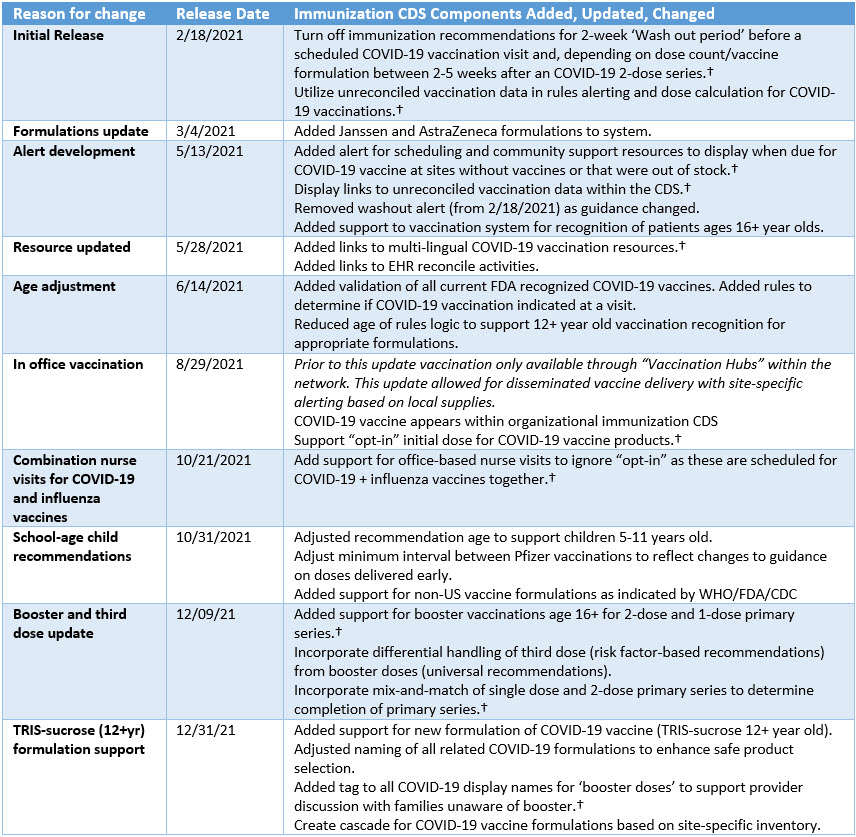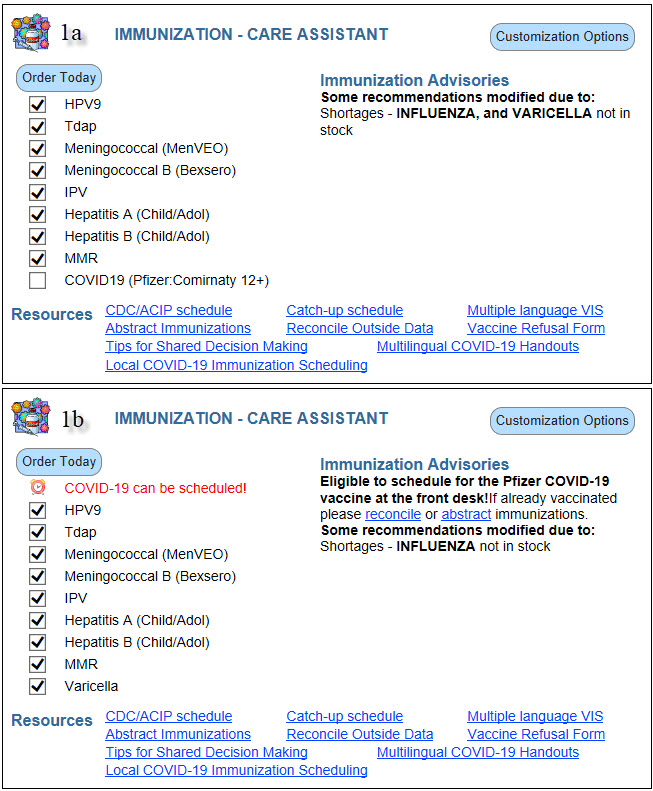Immunizations/Delivery
Category: Abstract Submission
Immunizations/Delivery I
505 - Implementation and Maintenance of COVID-19 Vaccination Rules Logic Using a Combination of Standard and Novel Clinical Decision Support Functions
Sunday, April 24, 2022
3:30 PM - 6:00 PM US MT
Poster Number: 505
Publication Number: 505.325
Publication Number: 505.325
Jeremy Michel, Childrens Hospital of Philadelphia, Bryn Mawr, PA, United States; Robert W. Grundmeier, Children's Hospital of Philadelphia, Ambler, PA, United States; Nghi Vo, CHOP, Philadephia, PA, United States; Karen M. Keough, Childrens Hospital of Philadelphia, Philadelphia, PA, United States; Elizabeth Brooks, Childrens Hospital of Philadelphia, Philadelphia, PA, United States; Nancy L. Cohen, Childrens Hospital of Philadelphia, Philadelphia, PA, United States; Jennifer Keller, Childrens Hospital of Philadelphia, Schwenksville, PA, United States; Colleen M. Schlotter, Childrens Hospital of Philadelphia, PERKASIE, PA, United States; Kathleen Filograna, Childrens Hospital of Philadelphia, Souderton, PA, United States; Scott Tomaine, CHOP Primary Care, Flourtown, Erdenheim, PA, United States; gregory lawton, Childrens Hospital of Philadelphia, CHESTERBROOK, PA, United States

Jeremy Michel, MD, MHS
Assistant Professor
Childrens Hospital of Philadelphia
Bryn Mawr, Pennsylvania, United States
Presenting Author(s)
Background: Rapid updates to COVID-19 vaccine recommendations coupled with periodic supply shortages require an adaptable framework for clinical decision support (CDS). We previously built a custom immunization calculator (the Care Assistant) to support recognition and ordering of vaccinations. New functions were required to support COVID-19 vaccination.
Objective: Develop, implement, and maintain an adaptable framework to support the identification of patients eligible for COVID-19 vaccination.
Design/Methods: We monitored national vaccination guidance surrounding COVID-19. As vaccine candidates were approved they were added to the Care Assistant. Rules were developed to identify when vaccinations could be given at different patient ages using product dose spacing intervals, which formulation to recommend based on patient and practice variables, factors that would alter vaccination recommendations, and validation of historical vaccinations. For each update we tested the recommendations against a comprehensive script. We connected our system to incoming registry data to incorporate vaccinations received by our patients at external facilities.
Results: We developed logic to determine the validity of historical doses for all nationally acceptable COVID-19 vaccine formulations. For available formulations, we developed logic for real-time vaccination recommendations. New features were added into the system to decrease waste of resources including (1) not preselecting COVID-19 vaccines for initial doses (an “opt-in” option) and (2) a CDS alerts to support community and future dose scheduling when a site expended all their vaccination supplies (Figure 1). In total, 10 major CDS rule changes related to COVID-19 vaccination were released into our system from 02/2021 to 12/2021 (Table 1). Utilization has resulted in opportunity vaccinations at 6740 physician visits and 3247 nurse visits.Conclusion(s): Leveraging already existing advanced CDS for immunizations, our organization rapidly adjusted to changes in COVID-19 vaccine recommendations to provide vaccination support within regular office visits. The CDS updates supported efficient and accurate patient identification, aligned with traditional workflows, and allowed vaccination to occur at what would otherwise be missed opportunities. Novel CDS functions were needed to address COVID-19 specific vaccination needs. The inclusion of a non-default (“opt-in”) selection for the initial dose helped avoid waste while allowing recognition.
Table 1: Immunization CDS updates related to COVID-19 vaccines †New CDS functions developed to support COVID-19 vaccine delivery in the office setting.
†New CDS functions developed to support COVID-19 vaccine delivery in the office setting.
Figure 1a-1b: Immunization Care Assistant updated to support COVID-19 vaccine delivery (1a). Immunization Care Assistant with support for COVID-19 vaccine ordering. New functionality includes not preselecting COVID-19 vaccine for the initial dose in order to decrease product waste and encourage discussion. Links to abstraction and reconciliation activities included to support incorporation of data from outside the network into the health record. (1b) When a site has expended all COVID-19 vaccination supplies, the message changes to a reminder to schedule vaccination at the front desk. This is presented instead of the traditional out of stock message (currently displayed for Influenza).
(1a). Immunization Care Assistant with support for COVID-19 vaccine ordering. New functionality includes not preselecting COVID-19 vaccine for the initial dose in order to decrease product waste and encourage discussion. Links to abstraction and reconciliation activities included to support incorporation of data from outside the network into the health record. (1b) When a site has expended all COVID-19 vaccination supplies, the message changes to a reminder to schedule vaccination at the front desk. This is presented instead of the traditional out of stock message (currently displayed for Influenza).
Objective: Develop, implement, and maintain an adaptable framework to support the identification of patients eligible for COVID-19 vaccination.
Design/Methods: We monitored national vaccination guidance surrounding COVID-19. As vaccine candidates were approved they were added to the Care Assistant. Rules were developed to identify when vaccinations could be given at different patient ages using product dose spacing intervals, which formulation to recommend based on patient and practice variables, factors that would alter vaccination recommendations, and validation of historical vaccinations. For each update we tested the recommendations against a comprehensive script. We connected our system to incoming registry data to incorporate vaccinations received by our patients at external facilities.
Results: We developed logic to determine the validity of historical doses for all nationally acceptable COVID-19 vaccine formulations. For available formulations, we developed logic for real-time vaccination recommendations. New features were added into the system to decrease waste of resources including (1) not preselecting COVID-19 vaccines for initial doses (an “opt-in” option) and (2) a CDS alerts to support community and future dose scheduling when a site expended all their vaccination supplies (Figure 1). In total, 10 major CDS rule changes related to COVID-19 vaccination were released into our system from 02/2021 to 12/2021 (Table 1). Utilization has resulted in opportunity vaccinations at 6740 physician visits and 3247 nurse visits.Conclusion(s): Leveraging already existing advanced CDS for immunizations, our organization rapidly adjusted to changes in COVID-19 vaccine recommendations to provide vaccination support within regular office visits. The CDS updates supported efficient and accurate patient identification, aligned with traditional workflows, and allowed vaccination to occur at what would otherwise be missed opportunities. Novel CDS functions were needed to address COVID-19 specific vaccination needs. The inclusion of a non-default (“opt-in”) selection for the initial dose helped avoid waste while allowing recognition.
Table 1: Immunization CDS updates related to COVID-19 vaccines
 †New CDS functions developed to support COVID-19 vaccine delivery in the office setting.
†New CDS functions developed to support COVID-19 vaccine delivery in the office setting.Figure 1a-1b: Immunization Care Assistant updated to support COVID-19 vaccine delivery
 (1a). Immunization Care Assistant with support for COVID-19 vaccine ordering. New functionality includes not preselecting COVID-19 vaccine for the initial dose in order to decrease product waste and encourage discussion. Links to abstraction and reconciliation activities included to support incorporation of data from outside the network into the health record. (1b) When a site has expended all COVID-19 vaccination supplies, the message changes to a reminder to schedule vaccination at the front desk. This is presented instead of the traditional out of stock message (currently displayed for Influenza).
(1a). Immunization Care Assistant with support for COVID-19 vaccine ordering. New functionality includes not preselecting COVID-19 vaccine for the initial dose in order to decrease product waste and encourage discussion. Links to abstraction and reconciliation activities included to support incorporation of data from outside the network into the health record. (1b) When a site has expended all COVID-19 vaccination supplies, the message changes to a reminder to schedule vaccination at the front desk. This is presented instead of the traditional out of stock message (currently displayed for Influenza).